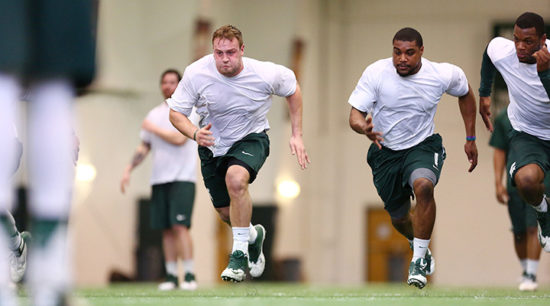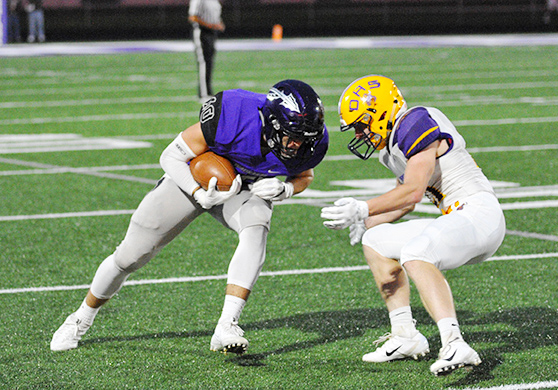Powerline: Enhancing summer conditioning components

In previous Powerline installments on conditioning, we have discussed the bioenergetics of the anaerobic energy system and how it governs explosive, high intensity activities. As a quick review, this system — which provides energy for approximately 20 to 30 seconds — draws upon adenosine triphosphate (ATP) and phosphocreatine (PC), which are both stored in muscles as the primary fuels for the athletic engine.
Beyond that time frame, the ATP-PC/LA System is called upon for energy substrate assistance. This would include work bouts in the one-to-three-minute window. As oxygen becomes a major player beyond that point, the LA/O2 and O2 systems take control.It must be noted that this energy generation is a complex continuum, with all phases contributing to some degree to the overall process. As a coach, you should design your summer training program to adhere to the following areas of specificity:
• Energy system specificity: This is in accordance with targeting the sport’s primary energy source in conditioning procedures.
• Movement specificity: With the motor memory aspects of training so vital, detailing the footwork, body posture and skill patterns of each position within the total framework is imperative.
• Open-based skill specificity: The incorporation of specific visual, auditory and pressure cues (e.g., a corner playing “press” coverage on a receiver) should be evident at various junctures in the conditioning process. The inclusion of sport/position specific, skill-pattern movements — which are sequenced in competition tempo — serve the dual purposes of skill acquisition and a conditioning effect.
• Tempo specificity: Regardless of the type of drills being conducted, they should be conducted with work:relief intervals that coincide their intensity, duration, or goal of eventual game replication. In football, for example, if your team is involved in a sequence of 12-play drives, at three to six seconds per play, with approximately 30 seconds between plays, a high level of conditioning is warranted.
At the high school level, many players go both ways and participate on just about every special team, thus accumulating 60 plays or more per game. It is not uncommon for collegiate football players to tally 80-plus plays per game. The summer conditioning program must be geared to meet the energy system requirements of these challenging stresses.
• Sport/position specificity: The only true method for garnering sport/position specificity is to be in the identical environment, using the exact equipment, wearing the proper gear and responding to all of the relative cues with the correct movements. However, there is a cadre of foot patterns and cognitive responses that can be honed during this period. In that sense, “similar” will do, when “specific” is not possible. The “Tips” section provides some suggestions along these lines in football.
Dynamics and flexibility
We always perform a series of dynamic activities prior to any type of workout, including strength training. Shunting blood to muscles in preparation for gradually increasing work intensities is crucial across a broad spectrum of performance and injury deterrence variables. We have a diverse menu of dynamic movements, and rotation with a lot of variety is a staple in this endeavor.
The entire dynamic lead-in can take anywhere from five to 10 minutes, depending upon the available time allotment and the number of drills chosen. During the offseason periods, we’ve been known to spend 15 to 20 minutes on the dynamic phase, as many of these drills provide conditioning benefits in themselves, especially when the tempo of their execution is gradually heightened.
Flexibility refers to the range of motion of a joint or a series of joints that are influenced by muscles, ligaments tendons, fascia and bony structures. This range of motion is very specific and dependent on the type of joint in question.
For example, the hip and shoulder complexes allow for greater mobility and flexibility than the knee, elbow, wrist or ankle joints. This is due to the differences in structural design and functional capabilities of each of these articulations. Thus, the rate and level of both the athlete’s initial flexibility and concurrent improvements is truly specific to the joint compartment in question.
It must be understood that there are a host of other indications — some alterable, others unalterable — dictating flexibility:
 • Soft-tissue tightness/compliance: Joint capsules, tendons and ligaments are predominately non-elastic connective structures and are not subject to substantial change as a result of stretching protocols. Actually, a certain degree of tendon stiffness can be beneficial in power output, which is a result of proper strength training and concurrent field work (i.e., sprint and agility training). Muscle and its fascia — a fibrous tissue that supports and separates muscles — usually contain more elastic properties, and therefore are more compliant and adaptable to modifications.
• Soft-tissue tightness/compliance: Joint capsules, tendons and ligaments are predominately non-elastic connective structures and are not subject to substantial change as a result of stretching protocols. Actually, a certain degree of tendon stiffness can be beneficial in power output, which is a result of proper strength training and concurrent field work (i.e., sprint and agility training). Muscle and its fascia — a fibrous tissue that supports and separates muscles — usually contain more elastic properties, and therefore are more compliant and adaptable to modifications.
• Age: How often have you marveled at the flexibility of young children? With age, our flexibility gradually and progressively decreases due to changes in the elastic properties of certain soft tissues. Activity levels also tend to decrease with age, which contributes to deteriorating flexibility.
• Body temperature: Warming the joint areas via dynamic-based procedures can produce up to a 20-percent increase in flexibility. This magnifies the importance of warm-up activities prior to engaging in stretching exercises. Blood and oxygen flow to the working musculature increase the internal temperature, a process that aids all activities to follow in so many important ways.
• Muscle imbalances: A severe imbalance between muscle groups (e.g., relatively weak hamstrings opposing relatively strong quadriceps) can place the weaker muscle compartment in a precarious disadvantage. The weaker compartment should be targeted for additional strength and flexibility work.
• Genetic predisposition: Every coach of every sport has at least a few athletes who have an inherent proclivity for unusual joint and muscle tightness. These individuals should be placed on an extensive mobility, dynamic and flexibility program in addition to an emphasis on a full-range strength-training protocol.
Get SET for IT
When we establish our standards for conditioning, staying true to the principles of interval training (IT) is job one. Interval training is the most efficacious method for improving anaerobic capacity. When sequenced with the speed, effort and tempo (SET) protocols to be described, and combined with sound nutrition, athletes improve their muscle’s ability to store more ATP and glycogen for energy production. Additionally, the process of gluconeogenesis — where lactate is eventually recycled via the liver to produce new energy substrate for the working muscles – becomes more efficient.
Here is our format for instituting the SET protocols for IT:
• Speed: The speed for every IT run must be understood and executed properly. A stride is faster than a jog, a fast stride is not full-speed, but it is faster than a stride, and a sprint is just that — an all-out effort.
• Effort: Regardless of the required speed, it will be maintained the entire designated distance and through the finish line.
• Tempo: Every IT run has a predicated work:relief ratio, which refers to amount of time delegated to recovery between intervals relative to the time it took to run the interval. Usually, the longer the run, the lower the intensity, and thus the work:relief ratio may be 1:2-3. For instance, a 60-second run would receive a two to three minute relief period. A shorter run of between six and 15 seconds would receive a 1:3-4 respite, or approximately 45 to 60 seconds.
• Introductory intervals: In the initial stage of the IT program, the intensity level should be in the low to moderate range. Be cautious not to rush into full-speed sprint sessions at the onset. We accomplish this with a series of runs in the ranges of 300 yards (marked-off around the perimeter of the football field), 110 yards (from the end line of a football field to the opposite goal line), and 106 yards (across the football field and back).
The assigned run times for each position group in football is as follows:
- Power (i.e., offensive/defensive line): 300s = 60 to 65 seconds, 110s and 106s = 19 to 20 seconds.
- Big skill (i.e., tight ends, linebackers, fullbacks, most quarterbacks, specialists): 300s = 50 to 55 seconds, 110s and 106s = 17 to 18 seconds.
- Skill (i.e., defensive backs, wide receivers, and running backs): 300s = 45 to 50 seconds, 110s and 106s = 15 to 16 seconds.
Note that the 110 and 106 run times are identical for each group to account for the change of direction required for the 106s (i.e., a foot touch on the opposite sideline).
We normally begin the introductory intervals with a goal of completing at least three-quarters of a mile in yardage, then progress to one mile, and finally up to a mile and a half (2,640 total yards).
After two to three weeks of SET ITs, we begin to “funnel” down to the shorter, high-intensity sprints with a faster recovery tempo. Additionally, we insert “skill-pattern” conditioning (check Tips section.)
Using caution
Here’s an important coaching point: The rate and level of progression you make over this period is dictated by the pre-existing conditioning level of your athletes. If they have been relatively sedentary during the period leading up to the IT program, you will need to make the necessary adjustments in total volume, intensity and recovery allotments. When in doubt, give your athletes the benefit of that doubt and ease them into the summer program. They will improve with due diligence and eventually make the appropriate adaptations to these new stresses. Remember to always err on the side of caution and common sense.
Always keep the goal in mind, which is to get them to the finish line healthy and in great condition.
Ken Mannie is the head strength and conditioning coach Michigan State University. His column, Powerline, appears regularly in Coach & Athletic Director magazine.





